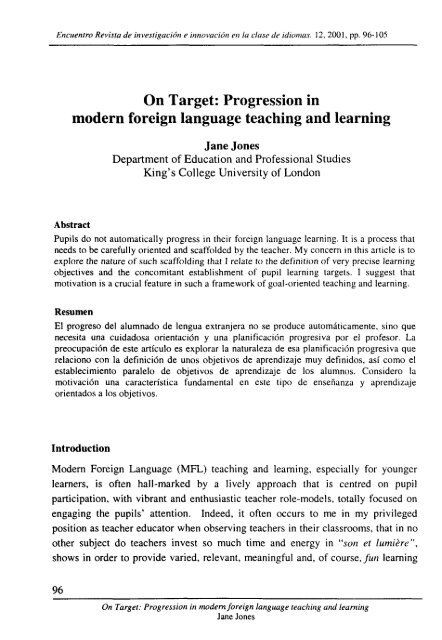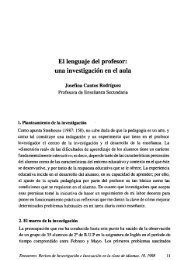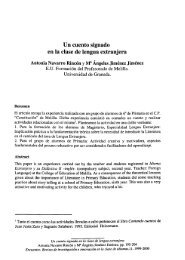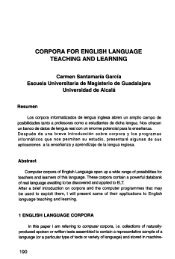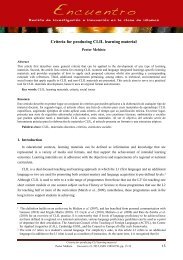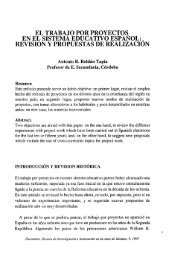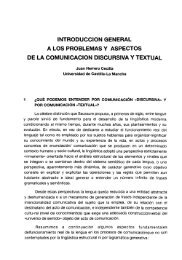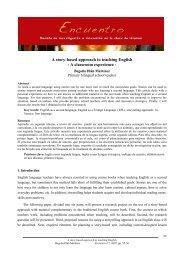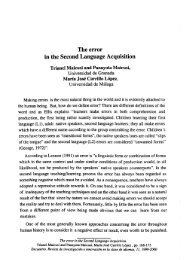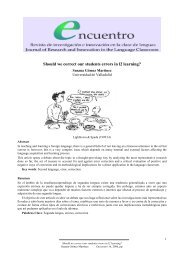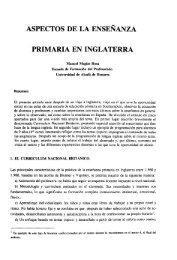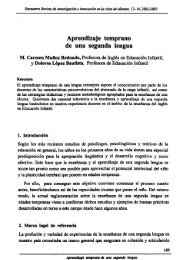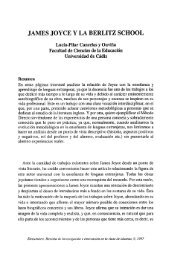On Target. Progression in Modern Foreign Language Teaching and ...
On Target. Progression in Modern Foreign Language Teaching and ...
On Target. Progression in Modern Foreign Language Teaching and ...
You also want an ePaper? Increase the reach of your titles
YUMPU automatically turns print PDFs into web optimized ePapers that Google loves.
Encuentro Revista de <strong>in</strong>vestigación e <strong>in</strong>novación en la clase de idiomas. 12, 2001, pp. 96-105<strong>On</strong> <strong>Target</strong>: <strong>Progression</strong> <strong>in</strong>modern foreign language teach<strong>in</strong>g <strong>and</strong> learn<strong>in</strong>gJane JonesDepartment of Education <strong>and</strong> Professional StudiesK<strong>in</strong>g's College University of LondonAbstractPupils do not automatically progress <strong>in</strong> their foreign language learn<strong>in</strong>g. It is a process thatneeds to be carefully oriented <strong>and</strong> scaffoided by the teacher. My concern <strong>in</strong> this article is toexplore the nature of such scaffold<strong>in</strong>g that I relate to the def<strong>in</strong>ition of very precise learn<strong>in</strong>gobjectives <strong>and</strong> the concomitant establishment of pupil learn<strong>in</strong>g targets. I suggest thatmotivation is a crucial feature <strong>in</strong> such a framework of goal-oriented teach<strong>in</strong>g <strong>and</strong> learn<strong>in</strong>g.ResumenEl progreso del alumnado de lengua extranjera no se produce automáticamente, s<strong>in</strong>o quenecesita una cuidadosa orientación y una planificación progresiva por el profesor. Lapreocupación de este artículo es explorar la naturaleza de esa planificación progresiva querelaciono con la def<strong>in</strong>ición de unos objetivos de aprendizaje muy def<strong>in</strong>idos, así como elestablecimiento paralelo de objetivos de aprendizaje de los alumnos. Considero lamotivación una característica fundamental en este tipo de enseñanza y aprendizajeorientados a los objetivos.Introduction<strong>Modern</strong> <strong>Foreign</strong> <strong>Language</strong> (MFL) teach<strong>in</strong>g <strong>and</strong> learn<strong>in</strong>g, especially for youngerleamers, is often hall-marked by a lively approach that is centred on pupilparticipation, with vibrant <strong>and</strong> enthusiastic teacher role-models, totally focused onengag<strong>in</strong>g the pupils' attention. Indeed, it often occurs to me <strong>in</strong> my privilegedposition as teacher educator when observ<strong>in</strong>g teachers <strong>in</strong> their classrooms, that <strong>in</strong> noother subject do teachers <strong>in</strong>vest so much time <strong>and</strong> energy <strong>in</strong> "son et lumiére",shows <strong>in</strong> order to provide varied, relevant, mean<strong>in</strong>gful <strong>and</strong>, of course, fun learn<strong>in</strong>g96<strong>On</strong> <strong>Target</strong>: <strong>Progression</strong> <strong>in</strong> modern foreign language teach<strong>in</strong>g <strong>and</strong> learn<strong>in</strong>gJane Jones
Encuentro Revista de <strong>in</strong>vestigación e <strong>in</strong>novación en la clase de idiomas. 12, 2001, pp. 96-105for their pupils. It is not surpris<strong>in</strong>g that MH^ teachers suffer pre-mature bumout <strong>and</strong>experience high mortality rates! The teachers' efforts are commendable but are notalways matched by parallel efforts on the part of the pupils. Whilst there are manyreasons for this, some of which I will discuss <strong>in</strong> this article, I beheve a ma<strong>in</strong> flaw ofthe ever shift<strong>in</strong>g pedagogy of MFL teach<strong>in</strong>g <strong>and</strong> learn<strong>in</strong>g (for centuries we haveendured methodological pendulum sw<strong>in</strong>gs <strong>in</strong> an apparentiy never-end<strong>in</strong>g <strong>and</strong>cont<strong>in</strong>u<strong>in</strong>g search for the "right method") is the lacle of <strong>in</strong>-built progression <strong>in</strong> ourplann<strong>in</strong>g sequences. This is often reflected <strong>in</strong> a rather unsequenced chunk approachto language teach<strong>in</strong>g <strong>and</strong> learn<strong>in</strong>g. It is an approach that leaves pupils unaware ofthe overall orientation of their learn<strong>in</strong>g, unaware of what they are aim<strong>in</strong>g for, bothshort term <strong>and</strong> longer term, unable therefore to sense a feel<strong>in</strong>g of mak<strong>in</strong>g progress,or of curriculum progression that would give such powerful feedback for furtherlearn<strong>in</strong>g. Lee, Buckl<strong>and</strong> <strong>and</strong> Shaw, for example, <strong>in</strong>terviewed 62 English pupils <strong>in</strong>the 13-14 years age range, (thus. <strong>in</strong> their third year <strong>in</strong> the secondary cycle), <strong>and</strong>concluded:The pupils have a limited view ofthe nature <strong>and</strong> process of learn<strong>in</strong>g aforeign language.This emerges through their <strong>in</strong>ability to talk, otlier than <strong>in</strong> vague ter<strong>in</strong>s, about what theyare <strong>in</strong>tended to learn, what has been learnt, <strong>and</strong> the extent to which they are successful<strong>in</strong> their learn<strong>in</strong>g, based on clear evidence <strong>and</strong> an underst<strong>and</strong><strong>in</strong>g of what is go<strong>in</strong>g on(1998:58).I suggest that the current climate of educational target-sett<strong>in</strong>g, a borrow fromeconomic discourse, can be useful if applied <strong>in</strong> a pupil-friendly way to pupils'learn<strong>in</strong>g, especially <strong>in</strong> conjunction with teachers' specification of clear learn<strong>in</strong>gobjectives. It is the exploration of such specificity <strong>in</strong> pedagogical <strong>and</strong> psychologicalterms that is the focus of this article.Def<strong>in</strong><strong>in</strong>g learn<strong>in</strong>g objectivesWhilst teachers are aware of the "big picture" of learn<strong>in</strong>g i.e. they are aware of theexam<strong>in</strong>ation syllabus <strong>and</strong> sometimes work with<strong>in</strong> a scheme of work or/<strong>and</strong> foUow acourse book that is compatible with the syllabus, it is the "small picture" of the<strong>in</strong>dividual lessons both as s<strong>in</strong>gle learn<strong>in</strong>g opportunities <strong>and</strong> as part of a unit oflearn<strong>in</strong>g that has most mean<strong>in</strong>g to pupils. The daily/weekly timetable is, after all,how the pupils experience their learn<strong>in</strong>g. The teacher's role <strong>in</strong> apportion<strong>in</strong>g <strong>and</strong>measur<strong>in</strong>g this learn<strong>in</strong>g as accurately as possible is crucial <strong>in</strong> order to plan for<strong>On</strong> <strong>Target</strong>: <strong>Progression</strong> <strong>in</strong> modemforeign language teach<strong>in</strong>g <strong>and</strong> learn<strong>in</strong>gJane Jones97_
Encuentro Revista de <strong>in</strong>vestigación e <strong>in</strong>novación en la clase de idiomas. 12, 2001, pp. 96-105progression. Let us at this po<strong>in</strong>t move towards the construction of a lessonbeg<strong>in</strong>n<strong>in</strong>g with what practica! language items we want to teach <strong>in</strong> order toexemplify this procedure.We need lessons to be varied, relevant <strong>and</strong> <strong>in</strong>terest<strong>in</strong>g, but we also need them tobe focused <strong>and</strong> targeted at specific learn<strong>in</strong>g objectives. Many lessons plans -I speal
Encuentro Revista de mvestigación e <strong>in</strong>novación en la clase de idiotnas. 12, 2001, pp. 96-105the specification of learn<strong>in</strong>g objectives that I articúlate <strong>in</strong> terms of performanceobjectives, might look like the follow<strong>in</strong>g example:By the end of the lesson, it is expected that pupils will be able to:• underst<strong>and</strong> 6 colours <strong>in</strong> context with 6 items of cloth<strong>in</strong>g through listen<strong>in</strong>g <strong>and</strong>read<strong>in</strong>g exercises• comb<strong>in</strong>e 3 colours with 3 items of cloth<strong>in</strong>g as a mínimum <strong>in</strong> structured oralproduction• extend the mínimum 3 spoken utterances <strong>in</strong>to sentences beg<strong>in</strong>n<strong>in</strong>g with "Iwear..." <strong>and</strong> say such a sentence correctly at least once• write the oral versión down, with teacher support if necessary, hav<strong>in</strong>g seen atleast 2 correct written models on the board or OHP• know someth<strong>in</strong>g about fashion <strong>in</strong> the target culture.As this is an <strong>in</strong>troductory lesson as far as the items of cloth<strong>in</strong>g areconcemed, I emphasise skills of <strong>in</strong>tensiva listen<strong>in</strong>g foUowed by speak<strong>in</strong>g <strong>in</strong> areal context i.e. pupils describ<strong>in</strong>g the clothes they are wear<strong>in</strong>g <strong>and</strong> byextensión their favourite weekend clothes, especially if they are wear<strong>in</strong>g adull school uniform. In other words, I aim to tum the l<strong>in</strong>guistic objectives<strong>in</strong>to relevant language use by the pupils so that they can say, <strong>and</strong> perhapswrite, someth<strong>in</strong>g mean<strong>in</strong>gful to them.I am also giv<strong>in</strong>g the lesson a cultural frame <strong>and</strong> specify this as a learn<strong>in</strong>gobjective too. Research, e.g. Oxymoron (1998), clearly <strong>in</strong>dicates that thecultural <strong>in</strong>put needs to be consciously planned if it is to be more than<strong>in</strong>cidental <strong>and</strong> anecdotal. As I wrote:Wliere [the teach<strong>in</strong>g of culture] was identified, it tended towards vagueness orsuperficiality appear<strong>in</strong>g alniost as an afierthouglit <strong>and</strong> focus<strong>in</strong>g on touristy orquestionable 'special events {Jones 1998:54).How then might such detailed plann<strong>in</strong>g be useful? The usefulness of this detallof plann<strong>in</strong>g serves two very important feedback functions. Firstly on a pedagogicallevel, it provides the teacher with a route to learn<strong>in</strong>g that can be assessed bothdiscretely <strong>and</strong> holistically. The overall evaluation at the end of the lesson whenconsider<strong>in</strong>g the evidence as to whether the <strong>in</strong>tended learn<strong>in</strong>g has taken place, will<strong>On</strong> <strong>Target</strong>: <strong>Progression</strong> <strong>in</strong> modemforeign language teach<strong>in</strong>g <strong>and</strong> learn<strong>in</strong>gJane Jones99
Encuentro Revista de <strong>in</strong>vestigación e <strong>in</strong>novación en la clase de idiomas. 12, 2001, pp. 96-105<strong>in</strong>form the teacher about the success or otherwise of the teach<strong>in</strong>g <strong>and</strong> leam<strong>in</strong>g <strong>in</strong>this lesson. Secondly, clear, irrefutable feedback can be given to the learners as towhat extent their targets for learn<strong>in</strong>g that will have been negotiated with them at anappropriate po<strong>in</strong>t have been achieved. The most entic<strong>in</strong>g foreign languageclassrooms are a profusión of cultural images <strong>and</strong> l<strong>in</strong>guistic support such as keytarget language transactions hang<strong>in</strong>g from the ceil<strong>in</strong>g <strong>and</strong> common verb paradigmson the wall. There would also be space for the pupils' learn<strong>in</strong>g targets, for example,written by the pupil on a piece of card, cut <strong>in</strong>to an <strong>in</strong>terest<strong>in</strong>g shape, dangl<strong>in</strong>g on alength of str<strong>in</strong>g or ribbon as <strong>in</strong> the example below.Motívatíon <strong>and</strong> goal-oríented learn<strong>in</strong>gPositive feedback for leam<strong>in</strong>g is a very powerful motivation <strong>and</strong> is allied to goaltheories that have become very <strong>in</strong>fluential <strong>in</strong> the last decade. Dornyei, review<strong>in</strong>g theresearch <strong>and</strong> literature, posits that there are four mechanisms by which goals affectperformance. These are:/. They direct attention <strong>and</strong> ejfort towards goal-relevant activities at the expense ofactions that are not relevant.2. They regúlate ejfort expenditure <strong>in</strong> that people adjust their efforts to the difficultylevel required by the task3. They encourage persistence until the goal is accomplished.4. They promote the searchfor relevant action plans or task strategies. (2000:26).As Dornyei asserts, the goals are not only ultímate, long-term goals but also"st<strong>and</strong>ards by which to evalúate one's performance provid<strong>in</strong>g a def<strong>in</strong>ition of100<strong>On</strong> <strong>Target</strong>: <strong>Progression</strong> <strong>in</strong> modern foreign language teach<strong>in</strong>g <strong>and</strong> learn<strong>in</strong>gJane Jones
Encuentro Revista de <strong>in</strong>vestigación e <strong>in</strong>novación en la clase de idiomas. 12, 2001, pp. 96-105success" (ibid.). This is very important for classroom-based language leam<strong>in</strong>gwhere the prospect of mastery must seem very distant <strong>in</strong>deed for many pupils. Thus,the sett<strong>in</strong>g of "proximal subgoals", i.e. short term <strong>and</strong> médium term objectives, willundoubtedly provide the motivat<strong>in</strong>g forcé needed for pupils <strong>in</strong> their rather longdistance joumey to language mastery, establish<strong>in</strong>g benchmarks of progress alongthe way, thus provid<strong>in</strong>g critical feedback for learn<strong>in</strong>g. It is strange to me thatteachers who can usually well articúlate such benchmarks do not always share themwith the learners. Educational research has found <strong>in</strong> several <strong>in</strong>stances that themajority of pupils <strong>in</strong> any ord<strong>in</strong>ary class do not fully underst<strong>and</strong> why they are<strong>in</strong>volved <strong>in</strong> any particular learn<strong>in</strong>g activity. As Lee et al. wrote:The pupils lack a alear view of what learn<strong>in</strong>g a language really means. They areunclear about what they are supposed to ga<strong>in</strong> fro<strong>in</strong> their lessons' (op.cit.3-4).Let US reitérate, then, the need to establish not just clear <strong>and</strong> specific targets, butones that challenge, are relevant <strong>and</strong> mean<strong>in</strong>gful to the learners. This has profoundimplications for teachers plann<strong>in</strong>g both short term <strong>and</strong> long term, especially for theplann<strong>in</strong>g of progression.<strong>Progression</strong>: from the familiar to the unfamiliarProgress must surely <strong>in</strong>volve mov<strong>in</strong>g from the familiar <strong>and</strong> relatively simple to theless familiar <strong>and</strong> more complex <strong>in</strong> a leam<strong>in</strong>g trajectory which teachers can use tohelp ma<strong>in</strong>ta<strong>in</strong> the <strong>in</strong>terest <strong>and</strong> motivation of their pupils. Progress refers to thepupils' ga<strong>in</strong>s <strong>in</strong> knowledge, skills <strong>and</strong> underst<strong>and</strong><strong>in</strong>g. <strong>Progression</strong> is the element <strong>in</strong>the plann<strong>in</strong>g process that enables learners to progress <strong>and</strong> that promotes "grow<strong>in</strong>gco<strong>in</strong>petence that is as <strong>in</strong>iicli concerned with the process of learn<strong>in</strong>g as withassess<strong>in</strong>g the result" (<strong>Modern</strong> <strong>Foreign</strong> <strong>Language</strong>s. The National Curriculum. 1999).<strong>Progression</strong> relates to the quality of the curriculum that enables pupils to build onwhat they have learned <strong>and</strong> is concemed with shifts along various cont<strong>in</strong>ua thatwould <strong>in</strong>clude:• range of vocabulary• complexity of structures• competence <strong>in</strong> the skills• <strong>in</strong>creas<strong>in</strong>g accuracy• socio-l<strong>in</strong>guistic adaptability<strong>On</strong> <strong>Target</strong>: <strong>Progression</strong> <strong>in</strong> modern foreign language teach<strong>in</strong>g <strong>and</strong> learn<strong>in</strong>gJane Jones101
Encuentro Revista de <strong>in</strong>vestigación e <strong>in</strong>novación en la clase de idiomas. 12, 2001, pp. 96-105• more advanced learner strategies• a shift from dependent to <strong>in</strong>dependent use of language• confidence <strong>and</strong> enjoyment <strong>in</strong> foreign language use.In Engl<strong>and</strong> , the government has <strong>in</strong>troduced a "literacy" <strong>in</strong>itiative that hasrequired primary schools <strong>and</strong>, as of September 2001, secondary schools to develop<strong>and</strong> deliver a particular content <strong>in</strong> a preferred way. This is to say that a "literacyhour" is compulsory <strong>in</strong> all primary schools every day whilst secondary schools forthe age range 11-14 must implement whole-school strategies on a whole schoolbasis. Whilst this is primarily but not exclusively aimed at English (mother tongue)teachers, MFL teachers (<strong>and</strong> <strong>in</strong>deed teachers of all subjects) are required to consider"literacy" as a cross-curricular learn<strong>in</strong>g opportunity. Teach<strong>in</strong>g strategies proposed<strong>in</strong>clude direct<strong>in</strong>g "to ensure pupils know what they sliould he doiiig", modeli<strong>in</strong>g,scaffold<strong>in</strong>g, expla<strong>in</strong><strong>in</strong>g, question<strong>in</strong>g, guid<strong>in</strong>g exploration <strong>and</strong> discuss<strong>in</strong>g (LiteracyStrategy 1998:8), a very familiar repertoire to MFL teachers. MFL teachers caneasily <strong>in</strong>terpret the requirements <strong>and</strong> what I suggest might be of particular use is thecont<strong>in</strong>uum of word-sentence-text that is a key feature of the work<strong>in</strong>g strategy. This<strong>in</strong>volves mov<strong>in</strong>g pupils rapidly from vocabulary lists to their manipulation <strong>in</strong>sentences <strong>and</strong> <strong>in</strong> texts of all k<strong>in</strong>ds. Pachler suggests a whole sale re-th<strong>in</strong>k ofmethodology to <strong>in</strong>corpórate this pr<strong>in</strong>cipie:It would seem therefore, that a re-exa<strong>in</strong><strong>in</strong>ation of the curreiit ai<strong>in</strong>s of FL teach<strong>in</strong>g <strong>in</strong>secondary education is desirable <strong>and</strong> that there is a need for the <strong>in</strong>clusión of thoughtprovok<strong>in</strong>gtexts <strong>and</strong> contexts which allow pupils to perfonn tasks that niake appropriatecognitive deni<strong>and</strong>s <strong>and</strong> e<strong>in</strong>phasise creativity, mov<strong>in</strong>g learners onfro<strong>in</strong> s<strong>in</strong>gle -word <strong>and</strong>short-phrase transactions <strong>and</strong> <strong>in</strong>teractions' (2000:31).Teachers' plann<strong>in</strong>g will need to take on board these cont<strong>in</strong>ua <strong>and</strong> plan, forexample, appropriate activities that <strong>in</strong> early stages provide máximum support <strong>and</strong>extensive <strong>and</strong> <strong>in</strong>tensive practice of familiar language <strong>in</strong> short bursts. As confidence<strong>and</strong> competence are developed, plann<strong>in</strong>g will focus more on enhanc<strong>in</strong>g more<strong>in</strong>dependent learn<strong>in</strong>g, comb<strong>in</strong><strong>in</strong>g the familiar with new lexis <strong>and</strong> grammaticalstructures, <strong>and</strong> <strong>in</strong>volv<strong>in</strong>g the learner as an active participant <strong>in</strong> the process.<strong>Progression</strong> can be developed thematically on a spirall<strong>in</strong>g basis, broaden<strong>in</strong>gcontext on all axes of teach<strong>in</strong>g <strong>and</strong> learn<strong>in</strong>g. Thus, for example, the familiar topic of"personal details" would move, I suggest, form a very simple nam<strong>in</strong>g <strong>and</strong>Identification procedure at the first stage to richer descriptions <strong>in</strong>volv<strong>in</strong>g future102<strong>On</strong> <strong>Target</strong>: <strong>Progression</strong> <strong>in</strong> modern foreign language teach<strong>in</strong>g <strong>and</strong> learn<strong>in</strong>gJane Jones
Encuentro Revista de <strong>in</strong>vestigación e <strong>in</strong>novación en la clase de idiomas. 12, 2001. pp. 96-105plans, e.g. careers, on subsequent re-visits to the topics. The English NationalCurriculum for <strong>Modern</strong> <strong>Foreign</strong> <strong>Language</strong>s def<strong>in</strong>es 8 level descriptions for eachskill área, <strong>in</strong>to which progression is <strong>in</strong>-built (<strong>and</strong>, <strong>in</strong>cidentally this is the sort oflevell<strong>in</strong>g exercise any group of language teachers can undertake). What teachersoften struggle with is exactly how to plan for pupils to move from one level to thenext. What I am suggest<strong>in</strong>g is that cióse attention to the learn<strong>in</strong>g objectives greatlyfacilitates this exercise s<strong>in</strong>ce these objectives can be matched to the levéis <strong>and</strong>suitable activities planned to move pupils on to another level. Without such detailedscrut<strong>in</strong>y, the exercise is much more difficult to do. Above all the pupils need toknow what they must target to enable them to move to the next level. As Dórnyei<strong>in</strong>sists, this makes the pupils focused <strong>in</strong> their learn<strong>in</strong>g. It also provides a focus totrack <strong>and</strong> assess learn<strong>in</strong>gTrack<strong>in</strong>g progress <strong>and</strong> monitor<strong>in</strong>gI mentioned earlier the issue of pre-plann<strong>in</strong>g for formative assessment. Readers willcerta<strong>in</strong>ly be familiar with these constructs. the degree of specificity I am urg<strong>in</strong>gshould enable teachers to keep details of <strong>in</strong>dividual pupils' progress towards <strong>and</strong>hopefully beyond their learn<strong>in</strong>g targets, especially where these are SMART targets.What are SMART targets? They are:SpecificMeasurableAchievableRelevantTime-relatedSMART targets can provide data, qualitative <strong>and</strong> quantitative accord<strong>in</strong>g to theassessment methods used, that will enable a re-focus<strong>in</strong>g of future targets for futurelearn<strong>in</strong>g. Such data also provide a good class overview where pupils' progress canbe compared; they also provide learn<strong>in</strong>g management data enabl<strong>in</strong>g classes to becompared. <strong>Target</strong>-sett<strong>in</strong>g is most certa<strong>in</strong>ly a useful monitor<strong>in</strong>g device for teachers<strong>and</strong> for subject leaders <strong>and</strong> s<strong>in</strong>ce it <strong>in</strong>volves prediction <strong>and</strong> reconciliation of targets,locates itself <strong>in</strong>to a culture of learn<strong>in</strong>g improvement. <strong>Target</strong>-sett<strong>in</strong>g is useful forp<strong>in</strong>po<strong>in</strong>t<strong>in</strong>g under-achievement <strong>in</strong> pupils i.e. those pupils who fail to "hit target"<strong>On</strong> <strong>Target</strong>: <strong>Progression</strong> <strong>in</strong> modern foreign language teach<strong>in</strong>g <strong>and</strong> learn<strong>in</strong>gJane Jones103_
Encuentro Revista de <strong>in</strong>vestigación e <strong>in</strong>novación en ¡a clase de idiomas. 12, 2001, pp. 96-105<strong>and</strong> special support can be negotiated with the pupil accord<strong>in</strong>g to need. Individualtarget-sett<strong>in</strong>g is an effective way of enabl<strong>in</strong>g pupils to experience a measure ofcontrol <strong>and</strong> of ownership of their own learn<strong>in</strong>g, especially important <strong>in</strong> MFLleam<strong>in</strong>g where, as commented, previously, the ultímate goals are so often severalyears distant <strong>and</strong> where motivation may flag. In their list of 12 suggestions formotivat<strong>in</strong>g language leamers, Williams <strong>and</strong> Burden (1997:141-2) <strong>in</strong>clude thefollow<strong>in</strong>g:• Discuss with leamers why they are carry<strong>in</strong>g out activilies• Involve learners <strong>in</strong> mak<strong>in</strong>g decisions related to learn<strong>in</strong>g the language• Involve learners <strong>in</strong> sett<strong>in</strong>g language- learn<strong>in</strong>g goals• Give feedback that is <strong>in</strong>formational.This k<strong>in</strong>d of discussion would go some way to help clear ihQfog engulf<strong>in</strong>g thosepupils <strong>in</strong>terviewed by Lee at al. exemplified <strong>in</strong> a quote from one pupil who said"Copy<strong>in</strong>g, not learn<strong>in</strong>g. Don't know what it means or how to pronounce ií"(op.cit.:24).There can be no doubt that progression is a feature of effective learn<strong>in</strong>g.<strong>Progression</strong>, we have asserted, <strong>in</strong>volves mov<strong>in</strong>g form the known to the unknown<strong>and</strong> the teacher's role is to construct a firm bridge. It is natural to be a little anxiousabout the unknown, about the await<strong>in</strong>g challenge, for as Holmes (1994:34) writes:We are all reluctant to some extent to step outside the circle of exist<strong>in</strong>gexperience...There is <strong>in</strong>uch to be ga<strong>in</strong>ed by <strong>in</strong>volv<strong>in</strong>g learners, discuss<strong>in</strong>g ways toimprove the quality of their learn<strong>in</strong>g environment <strong>and</strong> negotiat<strong>in</strong>g ways <strong>in</strong> whicli topromote more spontaneous use oftlie target language.Creemers' sem<strong>in</strong>al study (1994) of effective teach<strong>in</strong>g found certa<strong>in</strong> dimensionsof teacher behaviour to be crucial <strong>in</strong> promot<strong>in</strong>g effective learn<strong>in</strong>g. <strong>On</strong>e suchbehaviour <strong>in</strong>volved the sett<strong>in</strong>g of clear goals, <strong>in</strong> one sense restrict<strong>in</strong>g the possiblerange of goals <strong>and</strong> thus plac<strong>in</strong>g emphasis on basic skills, cognitive learn<strong>in</strong>g <strong>and</strong>transfer. The use of "advance organisers" -<strong>and</strong> the establishment of prior learn<strong>in</strong>gobjectives is one such "advance organiser"- was also found very helpful to pupils <strong>in</strong>the focus<strong>in</strong>g of their leam<strong>in</strong>g.104<strong>On</strong> <strong>Target</strong>: <strong>Progression</strong> <strong>in</strong> modem foreign language teach<strong>in</strong>g <strong>and</strong> learn<strong>in</strong>gJane Jones
Encuentro Revista de <strong>in</strong>vestigación c <strong>in</strong>novación en la clase de idiomas. 12, 2001, pp. 96-105Conclud<strong>in</strong>g remarksLearn<strong>in</strong>g, then , it seems to me, is about mov<strong>in</strong>g but <strong>in</strong>terconnected targets. Pupilsneed to be helped to develop a repertoire of learn<strong>in</strong>g strategies from which they canselect <strong>in</strong> order to achieve their targets. <strong>Target</strong>ed <strong>and</strong> focused learn<strong>in</strong>g does notexelude flexibility for as the comprehensive plann<strong>in</strong>g document, The CommonEuropean Framework of Reference for <strong>Language</strong>s <strong>in</strong>sists, teachers <strong>and</strong> learnersneed to develop an awareness of "the possibility <strong>and</strong> acceptability of differentoutcomes as opposed to learners (perhaps subconscious } striv<strong>in</strong>g for a s<strong>in</strong>gle'correct' outcome" (2002:163). The paradox of a structured learn<strong>in</strong>g approach is <strong>in</strong>its l<strong>in</strong>guistic empowerment enabl<strong>in</strong>g the pupil to be creative <strong>in</strong> language use from asecure knowledge basis.ReferencesCreemers, B. 1994. The Effective Classroom. London: CassellCouncil of Europe. 2001. Co<strong>in</strong><strong>in</strong>on European Framework <strong>in</strong> <strong>Language</strong>s: Learn<strong>in</strong>g,teach<strong>in</strong>g, assessment. Cambridge: CUPDepartment for Education <strong>and</strong> Employment. 1998. The National Literacy Strategy. London:DfEEDepartment for Education <strong>and</strong> Employment. 1999. <strong>Modern</strong> <strong>Foreign</strong> <strong>Language</strong>s. TheNational Curriculum for Engl<strong>and</strong>. London: DfEEDornyei, Z. 2001. Teach<strong>in</strong>g <strong>and</strong> Researclüng Motivation. Harlow: Longman.Holmes, B .1994. Keep<strong>in</strong>g on <strong>Target</strong>. Pathfínder 23. London: CiLTIntercultural Learn<strong>in</strong>g <strong>and</strong> Early <strong>Foreign</strong> <strong>Language</strong> teach<strong>in</strong>g <strong>and</strong> learn<strong>in</strong>g, (Oxymoron).Italy: Grafital.Jones, J .1998. Teach<strong>in</strong>g Diaries: an exercise <strong>in</strong> reflexivity <strong>in</strong> Same dijferences.Lee, J., Buckl<strong>and</strong>, D <strong>and</strong> Shaw, G. 1998. The Invisible Child. London : CiLTMiller, G. 1956. The magical number seven, plus or m<strong>in</strong>us two:some limits <strong>in</strong> our capacityfor process<strong>in</strong>g Information, <strong>in</strong> Psychological Review, 63, pp.81-97.Pachler, N. 2000. Re-exam<strong>in</strong><strong>in</strong>g communicative language teach<strong>in</strong>g <strong>in</strong> Field, K (ed.) Issues<strong>in</strong> <strong>Modern</strong> <strong>Foreign</strong> <strong>Language</strong>s Teach<strong>in</strong>g. London: RoutledgePalmer.Same differences.Intercultural learn<strong>in</strong>g <strong>and</strong> early foreign language teach<strong>in</strong>g. 1997.Oxymoron. Italy:GrafitaI.Williams, M & Burden, R. 1997. Psychology for <strong>Language</strong> Teachers. Cambridge: CUP<strong>On</strong> <strong>Target</strong>: <strong>Progression</strong> <strong>in</strong> modern foreign language teach<strong>in</strong>g <strong>and</strong> learn<strong>in</strong>gJane Jones105


